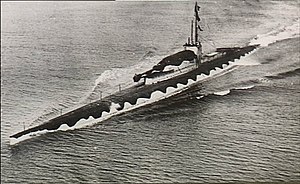This article includes a list of general references, but it lacks sufficient corresponding inline citations. (February 2013) |

| |
| Class overview | |
|---|---|
| Name | M-class submarine |
| Builders | Armstrong Whitworth, Vickers |
| Built | 1916–1919 |
| In commission | 1920–1932 |
| Planned | 4 |
| Completed | 3 |
| Cancelled | 1 |
| Lost | 2 |
| General characteristics | |
| Displacement |
|
| Length |
|
| Beam | 24 ft 8 in (7.52 m) |
| Propulsion |
|
| Speed |
|
| Range |
|
| Test depth | 200 ft (61 m) - M2 accidentally reached 239 ft (73 m) in 1923 |
| Complement | 62 |
| Armament |
|
| Aircraft carried | M2 converted to carry Parnall Peto seaplane |
The British Royal Navy M-class submarines were a small class of diesel-electric submarines built during World War I. The unique feature of the class design was a 12-inch (305 mm) gun mounted in a casemate forward of the conning tower.
Due to the limitations imposed on submarine armament by the Washington Naval Conference, M2 and M3 had their guns removed. M2 was converted to carry a small seaplane and M3 was made into a minelayer.